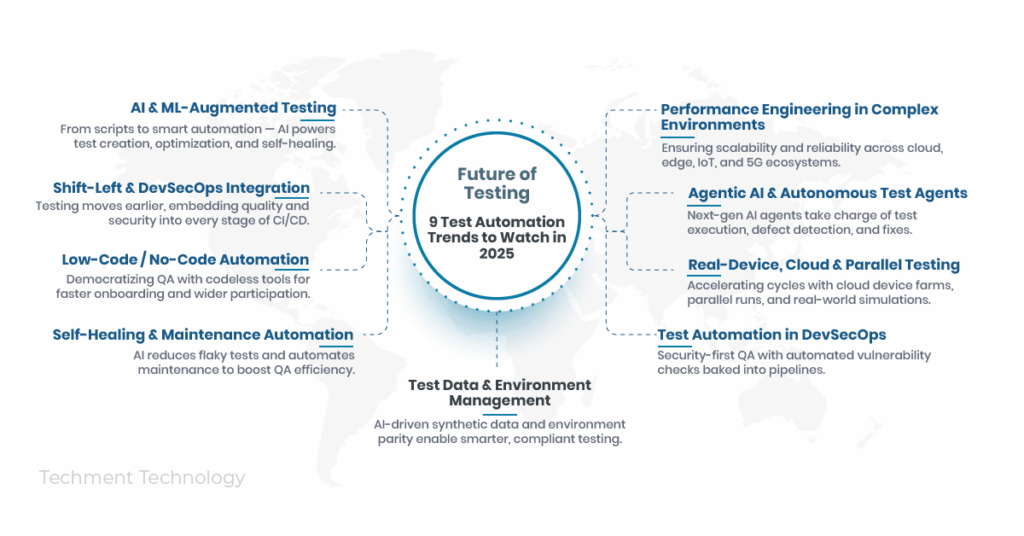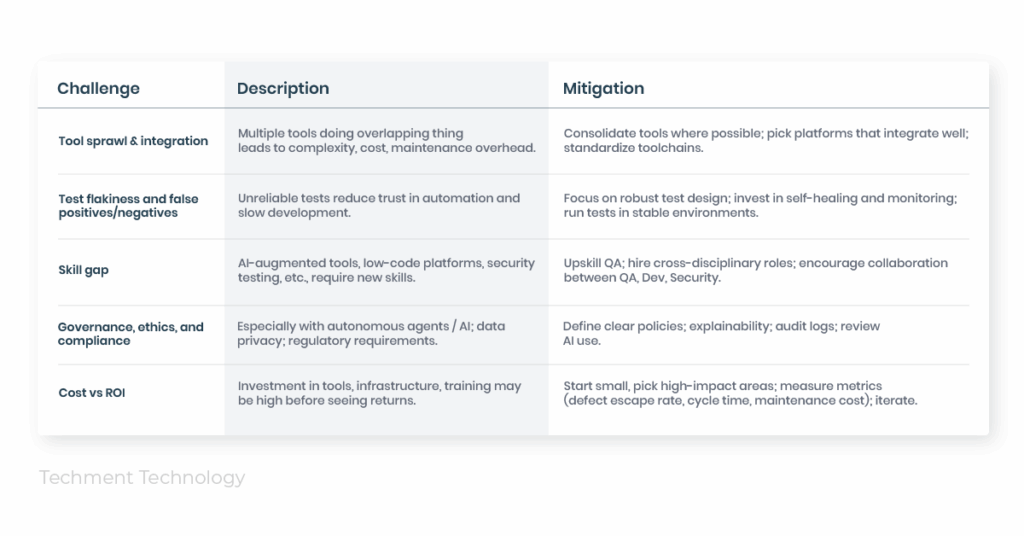Test Automation Trends 2025 are shaping how organizations deliver smarter, faster, and more reliable software in a rapidly evolving digital landscape. As digital transformation accelerates and customer expectations skyrocket, organizations are under pressure to deliver flawless software with speed and minimal overhead. Test Automation Trends 2025 are set to be a defining factor in who succeeds and who lags.
For CTOs, QA leaders, and product managers, understanding these trends is not optional — it’s essential. This article explores the most significant movements in test automation for 2025: what’s gaining traction, what’s fading, and how to adapt your processes, tools, and mindsets to deliver high quality at velocity.
TL;DR
- AI/ML-driven testing tools are becoming foundational: script generation, test maintenance, defect prediction.
- Shift-left, DevOps, and DevSecOps practices continue to expand, bringing testing earlier, integrating security, and embedding QA throughout development cycles.
- Low-code/no-code and self-healing automation reduce skill-barriers and maintenance overhead.
- Performance and reliability in complex architectures (microservices, cloud, IoT) are pushing trends like performance engineering, real-device/cloud testing, and parallelization.
- Challenges include test flakiness, integrating agentic AI governance, balancing automation vs human insight, and managing the cost & complexity of scaling.
- AI & ML-Augmented Testing Becomes Table Stakes
Modern test automation is no longer “automation + scripts” — it’s automation enriched with intelligence.
- According to the State of Quality Report 2025, ≈ 72.88% of organizations plan to increase automation coverage, and ≈ 67.16% are investing in AI/ML technologies. Katalon
- Use cases: generating test cases from natural language; optimizing existing test suites; defect prediction; auto-maintenance of broken tests (self-healing). BrowserStack+2Gartner+2
- As per TestGuild, by 2024 about 72.3% of teams were exploring or adopting AI-driven test workflows. Test Guild
Learn how Techment leverages AI-powered tools to reduce test maintenance costs.
What leaders should watch for:
- Choose tools or platforms that integrate AI in meaningful phases (test creation, maintenance, anomaly detection).
- Ensure governance & explainability of AI/ML tools: bias, reliability, human oversight.
- Plan for skills upskilling: data scientists + QA + DevOps collaboration.
- Shift-Left & DevOps / DevSecOps Integration
Testing earlier in the lifecycle, continuous testing, integration with CI/CD — these aren’t new, but they are becoming deeper and broader.
Read our DevSecOps case studies to understand embedding security in QA processes.
- Testrail’s report identifies “Shift-Left Testing” as one of the top trends for 2025. TestRail | The Quality OS for QA Teams
- Alongside, security testing is becoming embedded: DevSecOps, continuous vulnerability scanning, integrating security tests into pipelines. BrowserStack in its “20 Test Automation Trends in 2025” calls out “Test Automation in DevSecOps” as a major trend. BrowserStack
Key considerations:
- Architecture matters: microservices, serverless, and distributed systems require different test strategies.
- Early collaboration among developers, QA, security teams.
- Use test data & environments early to validate design decisions, not just code.
- Low-Code / No-Code & Scriptless Automation
The push to reduce dependency on highly technical test engineers continues. Enabling testers (and sometimes non-testers) to contribute more directly via visual tools or natural language.
- Gartner’s Peer Community noted ~53% believe low-code/no-code will impact automated software testing. Gartner
- BrowserStack lists “Codeless API Testing” and “Scriptless Automation Testing” among its top trends. BrowserStack
Pros & pitfalls:
- Pros: Faster onboarding, broader participation, faster prototyping.
- Pitfalls: Might sacrifice fine-grained control; may struggle with very complex scenarios; risk of “tool lock-in”.
Explore how AI-driven tools enable codeless automation.

- Self-Healing & Maintenance Automation
Test flakiness and maintenance overhead are major drains on QA effectiveness. Self-healing tools are emerging to reduce manual burden.
- In the BrowserStack list, “Self-Healing Automation” is explicitly enumerated. BrowserStack
- AI/ML tools are also being used for test suite optimization and defect prediction, which helps preempt maintenance demands. Katalon+1
Implementation suggestions:
- Identify flaky tests early; incorporate monitoring to detect test failures that are likely environmental vs code defects.
- Use modular, loosely coupled test design. Leverage tools that support dynamic element locators, adaptive wait strategies.
- Balance automation maintenance vs writing new tests.
See how Techment helps organizations implement resilient self-healing automation.
- Performance Engineering & Testing in Complex Environments
As systems grow in complexity (microservices, cloud, edge, IoT, mobile networks like 5G), performance, scalability, and real-world reliability matter more.
- BrowserStack trend list includes “Performance Engineering,” “IoT Testing Automation,” “5G Network Testing,” etc. BrowserStack
- According to GlobalAppTesting stats, the software testing market is growing fast (automation included), with pressure from real-device testing and diverse deployment environments. Global App Testing+1
Key strategies:
- Test in environments that are close to production: real devices, cloud infrastructure, network variability.
- Include performance as part of CI/CD, not just as a “pre-release test.”
- Monitor performance in production, use observability to feed into test suites.
Read our case study on performance engineering in complex systems.
- Agentic AI & Autonomous Test Agents
This is one of the more futuristic / ambitious trends: test agents that can act autonomously, detect issues, initiate corrective actions or suggest fixes without continuous human direction.
- Gartner’s Top Strategic Trends for 2025 includes Agentic AI — AI agents capable of autonomous decision-making. Gartner+1
- Also, per Reuters / Gartner, over 40% of agentic AI projects are predicted to be scrapped by 2027 due to cost, unclear value, or immaturity. But that also signals that those that succeed will drive significant competitive advantage. Reuters
What to evaluate:
- Define what “agentic” means for your context (e.g. test generation, test execution, maintenance).
- Start with pilot projects; define metrics of value (reduced maintenance cost, fewer escaped defects, faster time to fix).
- Pay attention to risk: autonomy requires strong governance, logging, traceability, especially in regulated industries.
Discover how AI in software testing is evolving in 2025.
- Real-Device, Cloud & Parallel Testing
To ensure consistent experience across devices, browsers, platforms, and geographies, real-device & cloud-based testing, along with parallel execution, are gaining ground.
- BrowserStack and others are emphasizing cloud testing and parallel test execution to reduce test cycle times. BrowserStack+1
- Real-device/browser diversity is especially relevant for mobile apps, IoT devices, and web clients with varying configurations.
Best practices:
- Use device farms or device clouds, with a good mix of real devices.
- Incorporate geolocation and network condition simulation.
- Prioritize which platforms/devices/browsers matter most for your user base.
Read our Mobile Testing Without Limits: Accelerate Quality with AI-powered Test Automation.
- Test Automation in DevSecOps & Security-First Testing
Security can’t be an afterthought, especially with growing cyber threats, compliance demands, and data privacy regulations.
- DevSecOps practices are being adopted more frequently: integrating security checks, vulnerability scanning, even “security test as code.” BrowserStack’s trend list marks DevSecOps strong. BrowserStack
- Security testing tools are increasingly automated, built into pipelines, but still require human input to interpret results and manage risk.
What to build:
- Embed security tests (e.g. static analysis, dynamic scanning, dependency checks) early.
- Train QA teams in security thinking; ensure security and QA collaboration.
- Use automated tools but also do threat modelling & manual review in sensitive areas.
Explore our Security Testing and DevSecOps practices.
- Test Data & Environment Management
Often overlooked, but test data, environment parity, and data privacy will be a differentiator in 2025.
- According to the State of Quality Report, many testers cited insufficient time and data or environment constraints as big challenges. Katalon
- Synthetic data generation (often AI-driven) is getting more traction to avoid privacy issues and to allow broader coverage. BrowserStack also lists “AI-Driven Test Data Generation.” BrowserStack
How to approach:
- Maintain environment parity (dev, staging, prod-like).
- Use synthetic or anonymized data for testing.
- Automate environment provisioning (containers, mocks, stubs) to avoid environment bottlenecks.
See how AI-driven test data generation is transforming QA.
What Challenges Will You Face
Even with these exciting trends, CTOs, QA leaders, and Product Managers must be aware of the pitfalls:

Strategic Recommendations for Leaders (CTOs / QA Leads / Product Managers)
- Audit and Prioritize Automation Coverage
Identify high-risk areas (regression, key user flows, security, performance) and focus automation there first. - Balance Speed with Quality
Shift-left, continuous testing, but don’t forget usability, user experience, and real-world conditions. Automation supports, but human insight still matters. - Invest in Scalable Infrastructure
Cloud testing, device farms, parallel test execution, containerized environments, and infrastructure that supports rapid feedback cycles. - Define Measurement & Feedback Loops
Use metrics like test coverage, flakiness rate, escaped defects, time to test / fix, test maintenance cost. Incorporate production monitoring into QA strategy. - Foster Cross-Functional Collaboration
QA, Development, DevOps, Security, Data Science alignment will be key. Encourage shared ownership of quality, not just QA owning “testing”. - Pilot New Technologies Mindfully
Try agentic AI, self-healing tests, etc., on smaller, less risky projects first; assess value; scale those that deliver measurable ROI.
Data & Stats Snapshot
- 82% of testers still use manual testing in daily work; ~45% automate regression testing. Katalon
- 61% express strong interest in exploring AI-driven testing; 72% use AI tools like ChatGPT, GitHub Copilot for test case & script generation. Katalon
- AI/ML adoption for test automation has increased from 7% in 2023 to 16% in 2025. Testlio
- Over 40% of agentic AI projects may be canceled by end-2027, per Gartner, due to unclear business value and costs. Reuters
FAQ
Q1: Will AI replace QA engineers by 2025?
No — but it will change what QA engineers do. AI can automate repetitive tasks (script generation, smoke/regression test maintenance), allowing QA to focus more on strategy, exploratory testing, user-experience, security and trust. Many respondents report changes in QA daily responsibilities rather than wholesale replacement. Gartner+1
Q2: How do I begin implementing “self-healing test automation”?
Start by identifying frequently failing/flaky tests. Use tools that support dynamic locators, retries, auto-repairs of scripts. Monitor failures to classify which are environment vs code related. Begin with pilot tests where ROI is visible.
Q3: What metrics should we track to measure success of test automation?
Use metrics such as: test coverage (functional, regression), escaped defect rate, test execution time, maintenance cost (how many hours spent fixing broken tests), flakiness rate, feedback loop time in CI/CD, defect severity found in production vs earlier phases.
Q4: How to balance automation vs manual testing?
Automate what is repeatable, risk-sensitive, or prone to regression. Manual testing adds value in exploratory testing, UX, edge-cases, integration with non-automatable parts (e.g. human behaviour). Always include manual review especially for usability, design flows. Cross-team collaboration helps decide what to automate.
Q5: What are the risks with using agentic AI in test automation?
Risks include high cost, unclear business value, overpromising vs underdelivering, governance / compliance issues, and loss of traceability or control. Vendor “agent washing” (claiming autonomy where there is little) is a concern. It’s important to pilot, define clear metrics, have human oversight, logging, rollback options. Reuters
Conclusion
Test Automation Trends 2025 signal a pivotal moment: automation is becoming smarter, more integrated, more pervasive — but complexity, governance, and strategic investment are no longer optional. For CTOs, QA leaders, and Product Managers, success will come from combining innovation (AI, agentic tools, self-healing) with solid foundation practices (shift-left, performance engineering, environment parity, security) and measuring what matters.
At Techment, we help organizations navigate these transitions — from assessing current test automation maturity to implementing AI-augmented tools, establishing DevSecOps practices, and optimizing test coverage. If you’re ready to scale quality, increase speed, and reduce risk, let’s explore how Techment can support your journey in test automation excellence.
Start with a Test Automation Assessment or Explore our Test Automation Implementation services.
Related Reads
- Quality Assurance & Automated Testing Services – Explore how we help enterprises achieve robust, scalable QA.
- Boosting Test Automation Resilience with AI-powered Tools – Discover how AI reduces test maintenance costs.
- VTop Software Testing Trends 2025: AI & ML Take Charge – Deep dive into AI-driven automation adoption.
 All Posts
All Posts